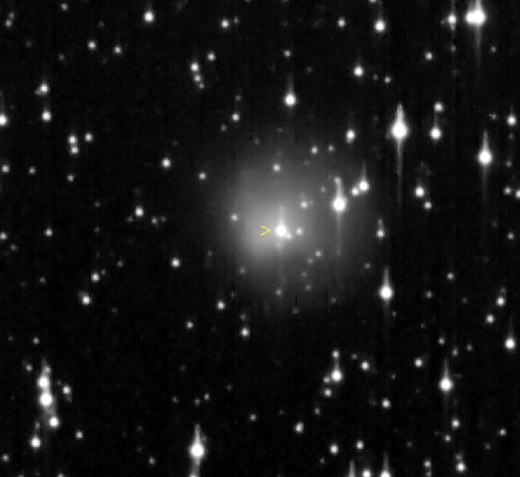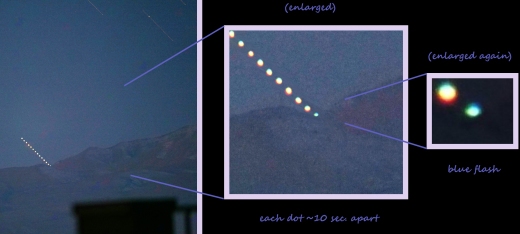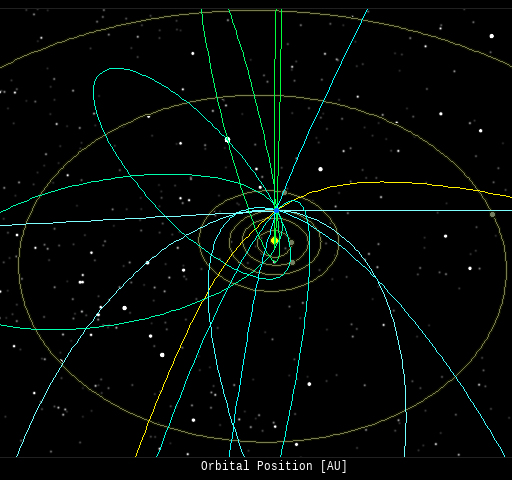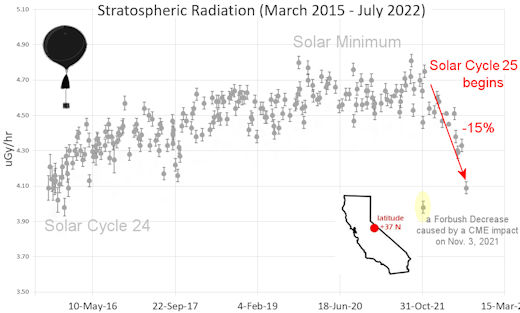Never miss another geomagnetic storm. Sign up for Space Weather Alerts and you'll receive a text message when magnetic storms erupt. Aurora tour guides and professional astronomers use this service. You can, too! | | |
INTERPLANETARY SHOCK WAVE: A shock wave in the solar wind hit Earth's magnetic field during the late hours of Dec. 18th. The impact opened a crack in our planet's magnetosphere, setting the stage for possible G1-class geomagnetic storms on Dec. 19th. The shock wave may have been a CME emitted last week by sunspot AR3165 during its hyperactive flurry of solar flares. Solar flare alerts: SMS Text.
PROBING THE ATMOSPHERE OF A CRYOVOLCANIC COMET: This morning a very rare stellar occultation was visible from Taiwan and parts of North America. Cryovolcanic comet 29P/Schwassmann-Wachmann passed directly in front of a 12th magnitude star. Using a robotic telescope in Mayhill, New Mexico, Eliot Herman took this picture of the star shining through 29P's atmosphere:

"The resolution of the 17 inch telescope was not sufficient to split the star from the solid body of 29P/Schwassmann-Wachmann," says Herman. "In this image they are a single point of light."
Hopefully, this is only the first of many images of the occultation taken from the Pacific-spanning shadow track. Plotting the star's light curve as it passed behind 29P will help trace the shape of the comet's solid body, which may be unusually spherical.
Moreover, 29P has erupted multiple times since late November--including one outburst on the eve of the occultation. The star will have passed behind residual clouds of outburst debris, allowing astronomers to probe the 'near space' around the comet's nucleus. Stay tuned for updates!
A 'BLUE FLASH' FROM SIRIUS: Sirius is so bright, you can see it even when it is very close to the horizon. Amateur astronomer Bob Beal of St. George, Utah, decided to take a closer look, and he found a 'blue flash':

"The timelapse photo shows Sirius setting behind the mountains southwest of town during morning twilight on Dec. 14th," says Beal.
The first exposures show a series of little rainbows. Sirius was spread into its constituent colors by the prismatic action of the low atmosphere. The last exposure is only blue.
"When Sirius hit the ridgeline, parts of its disk were behind the ridge, leaving blue as the last color to disappear," says Beal.
The sun can have blue flashes as well. But the sun requires a mirage to magnify its blue enough to be visible against surrounding blue sky. Sirius has the advantage of darkness; nighttime blue is easier to see. The fact that Sirius itself is blue may help, too.
Realtime Space Weather Photo Gallery
Free: Spaceweather.com Newsletter
GIFTS FROM THE EDGE OF SPACE: Christmas is coming. Are you looking for a far-out gift? Check out the Earth to Sky Store. It's filled with unique items that have flown to the edge of space onboard cosmic ray research balloons.

These unique gifts have floated above 99.7% of Earth's atmosphere, experiencing space-like blasts of cosmic rays, extreme cold, and a wild ride parachuting back to Earth after the balloon explodes. Even Amazon doesn't carry items this far out. Don't forget to enter coupon code "SPACESANTA" at checkout for a 10% holiday discount.
Far Out Gifts: Earth to Sky Store
All sales support hands-on STEM education
Realtime Aurora Photo Gallery
Free: Spaceweather.com Newsletter
Every night, a network of
NASA all-sky cameras scans the skies above the United States for meteoritic fireballs. Automated software maintained by NASA's Meteoroid Environment Office calculates their orbits, velocity, penetration depth in Earth's atmosphere and many other characteristics. Daily results are presented here on Spaceweather.com.
On Dec 19, 2022, the network reported 11 fireballs.
(10 sporadics, 1 December Leonis Minorid)

In this diagram of the inner solar system, all of the fireball orbits intersect at a single point--Earth. The orbits are color-coded by velocity, from slow (red) to fast (blue). [Larger image] [movies]
Potentially Hazardous Asteroids (
PHAs) are space rocks larger than approximately 100m that can come closer to Earth than 0.05 AU. None of the known PHAs is on a collision course with our planet, although astronomers are finding
new ones all the time.
On December 19, 2022 there were 2320 potentially hazardous asteroids.
 |
Recent & Upcoming Earth-asteroid encounters: | Asteroid | Date(UT) | Miss Distance | Velocity (km/s) | Diameter (m) |
| 2022 XY | 2022-Dec-14 | 11.4 LD | 4.4 | 25 |
| 2021 XS4 | 2022-Dec-14 | 14.5 LD | 9.7 | 23 |
| 2022 YP | 2022-Dec-14 | 5.8 LD | 7.6 | 9 |
| 2022 XX | 2022-Dec-14 | 0.5 LD | 6.6 | 7 |
| 2022 YR | 2022-Dec-14 | 3.6 LD | 19.1 | 12 |
| 2015 RN35 | 2022-Dec-15 | 1.8 LD | 5.9 | 85 |
| 2022 XO | 2022-Dec-15 | 8.4 LD | 8.6 | 20 |
| 2022 YM1 | 2022-Dec-17 | 1.6 LD | 2.7 | 4 |
| 2022 YO1 | 2022-Dec-17 | 0.1 LD | 15.4 | 4 |
| 2022 WU11 | 2022-Dec-17 | 11.7 LD | 10.6 | 31 |
| 2016 YE | 2022-Dec-18 | 18.6 LD | 4.8 | 23 |
| 2022 YJ | 2022-Dec-18 | 0.7 LD | 24.8 | 6 |
| 2022 WX5 | 2022-Dec-18 | 20.1 LD | 4.2 | 35 |
| 2022 YC | 2022-Dec-18 | 1 LD | 5 | 5 |
| 2022 XC1 | 2022-Dec-18 | 8.3 LD | 7.1 | 21 |
| 2022 YQ | 2022-Dec-19 | 4.2 LD | 14.7 | 8 |
| 2014 HK129 | 2022-Dec-20 | 6.7 LD | 11.6 | 216 |
| 2017 XQ60 | 2022-Dec-21 | 18.8 LD | 16 | 45 |
| 2022 YK | 2022-Dec-22 | 3.2 LD | 2.8 | 7 |
| 2022 YG | 2022-Dec-22 | 6.3 LD | 5.5 | 17 |
| 2022 UD9 | 2022-Dec-22 | 4.6 LD | 10.3 | 159 |
| 2022 RD2 | 2022-Dec-22 | 13.9 LD | 1.1 | 7 |
| 2022 YN | 2022-Dec-23 | 20 LD | 6.8 | 25 |
| 2022 YB | 2022-Dec-23 | 10.3 LD | 5.8 | 27 |
| 2022 YO | 2022-Dec-24 | 3.5 LD | 9.3 | 13 |
| 2022 XN | 2022-Dec-24 | 8.5 LD | 11 | 47 |
| 2022 XM1 | 2022-Dec-24 | 9.7 LD | 12.7 | 31 |
| 2022 YL1 | 2022-Dec-25 | 7.7 LD | 12.2 | 51 |
| 2013 YA14 | 2022-Dec-25 | 2.7 LD | 10.5 | 68 |
| 2022 TE14 | 2022-Dec-25 | 11.2 LD | 7 | 127 |
| 2018 YK2 | 2022-Dec-26 | 15.8 LD | 15.1 | 98 |
| 2022 YB1 | 2022-Dec-26 | 5.7 LD | 14.8 | 26 |
| 2022 YG1 | 2022-Dec-27 | 11.3 LD | 16 | 26 |
| 2022 WV9 | 2022-Dec-27 | 6.5 LD | 7.2 | 46 |
| 2010 XC15 | 2022-Dec-27 | 2 LD | 10.1 | 182 |
| 2022 XL1 | 2022-Dec-27 | 7.6 LD | 8.4 | 30 |
| 2022 YL | 2022-Dec-27 | 7.9 LD | 5.7 | 19 |
| 2021 AE | 2022-Dec-28 | 16.5 LD | 15 | 23 |
| 2021 NF | 2023-Jan-02 | 17.9 LD | 11.3 | 40 |
| 2011 WR41 | 2023-Jan-03 | 15.8 LD | 8.9 | 34 |
| 2019 AY3 | 2023-Jan-04 | 16.8 LD | 19.7 | 62 |
| 2022 YN1 | 2023-Jan-06 | 18.3 LD | 5.5 | 59 |
| 2021 TL | 2023-Jan-09 | 14.2 LD | 8.5 | 75 |
| 2014 LJ | 2023-Jan-14 | 4.8 LD | 3.5 | 7 |
| 2012 BV13 | 2023-Jan-16 | 12.2 LD | 6.7 | 134 |
| 2020 BP | 2023-Jan-20 | 5.2 LD | 16.9 | 26 |
| 2019 BO2 | 2023-Jan-24 | 12.1 LD | 16.2 | 21 |
| 2019 BZ4 | 2023-Jan-24 | 16.5 LD | 5.6 | 20 |
| 2020 BZ14 | 2023-Jan-26 | 8.8 LD | 6.7 | 54 |
| 2022 SO113 | 2023-Jan-29 | 10.5 LD | 3.5 | 73 |
| 2017 DU34 | 2023-Feb-02 | 13.3 LD | 11.2 | 16 |
| 367789 | 2023-Feb-03 | 4.7 LD | 9.9 | 149 |
| 2020 OO1 | 2023-Feb-04 | 4.8 LD | 7.7 | 19 |
| 2022 CX1 | 2023-Feb-09 | 17.4 LD | 13.2 | 14 |
| 2021 EP4 | 2023-Feb-13 | 19 LD | 6.1 | 5 |
| 199145 | 2023-Feb-16 | 12 LD | 24.6 | 756 |
| 2022 RG | 2023-Feb-16 | 8.2 LD | 3 | 24 |
Notes: LD means "Lunar Distance." 1 LD = 384,401 km, the distance between Earth and the Moon. 1 LD also equals 0.00256 AU. | | Cosmic Rays in the Atmosphere |
SPACE WEATHER BALLOON DATA: Almost once a week, Spaceweather.com and the students of Earth to Sky Calculus fly space weather balloons to the stratosphere over California. These balloons are equipped with sensors that detect secondary cosmic rays, a form of radiation from space that can penetrate all the way down to Earth's surface. Our monitoring program has been underway without interruption for 7 years, resulting in a unique dataset of in situ atmospheric measurements.
Latest results (July 2022): Atmospheric radiation is decreasing in 2022. Our latest measurements in July 2022 registered a 6-year low:

What's going on? Ironically, the radiation drop is caused by increasing solar activity. Solar Cycle 25 has roared to life faster than forecasters expected. The sun's strengthening and increasingly tangled magnetic field repels cosmic rays from deep space. In addition, solar coronal mass ejections (CMEs) sweep aside cosmic rays, causing sharp reductions called "Forbush Decreases." The two effects blend together to bring daily radiation levels down.
.Who cares? Cosmic rays are a surprisingly "down to Earth" form of space weather. They can alter the chemistry of the atmosphere, trigger lightning, and penetrate commercial airplanes. According to a study from the Harvard T.H. Chan school of public health, crews of aircraft have higher rates of cancer than the general population. The researchers listed cosmic rays, irregular sleep habits, and chemical contaminants as leading risk factors. A number of controversial studies (#1, #2, #3, #4) go even further, linking cosmic rays with cardiac arrhythmias and sudden cardiac death.
Technical notes: The radiation sensors onboard our helium balloons detect X-rays and gamma-rays in the energy range 10 keV to 20 MeV. These energies span the range of medical X-ray machines and airport security scanners.
Data points in the graph labeled "Stratospheric Radiation" correspond to the peak of the Regener-Pfotzer maximum, which lies about 67,000 feet above central California. When cosmic rays crash into Earth's atmosphere, they produce a spray of secondary particles that is most intense at the entrance to the stratosphere. Physicists Eric Regener and Georg Pfotzer discovered the maximum using balloons in the 1930s and it is what we are measuring today.
| | The official U.S. government space weather bureau |
| | The first place to look for information about sundogs, pillars, rainbows and related phenomena. |
| | Researchers call it a "Hubble for the sun." SDO is the most advanced solar observatory ever. |
| | 3D views of the sun from NASA's Solar and Terrestrial Relations Observatory |
| | Realtime and archival images of the Sun from SOHO. |
| | information about sunspots based on the latest NOAA/USAF Active Region Summary |
| | current counts of failed and deployed Starlink satellites from Jonathan's Space Page |
| | Authoritative predictions of space junk and satellite re-entries |
| | from the NOAA Space Environment Center |
| | fun to read, but should be taken with a grain of salt! Forecasts looking ahead more than a few days are often wrong. |
| | from the NOAA Space Environment Center |
| | the underlying science of space weather |
 | BestCSGOGambling is the best site for everything related to CSGO gambling on the web |
 | To find reviews of new online casino sites in the UK try The Casino DB where there are hundreds of online casino reviews complete with bonuses and ratings. Alternatively, Online-Casinos.xyz is another massive directory of online casinos listing sites for the UK and Worldwide. Casinos that offer Rupees for bonuses are very generous to Indian players. Find the best online casinos in India at AllCasinos.in Looking for a new online casino? Try Casimpo the new site dedicated to making online casino simple, or check out the new Avenger Slots Casino and Ace Online Casino with over 500 online slots and casino games. |
 | When looking for casinos to play online when the weather is bad, you can try casino online trucchi for Italian games. If you are not from Finland you can try the Swedish page Svenska casino online to find suitable games, check out svenskacasinoonline.net. Always check your local laws before playing with real money. |
 | Looking for sports betting companies not registered on GamStop? CasinoGap has presented a list of sites not on GamStop available for UK players. Check and bet online! Would you like to bet at sites not using GamStop? Look at a list of NonStopCasino sites for online betting that aren't on GamStop. Top-rated bookmakers ever! |
| | These links help Spaceweather.com stay online. Thank you to our supporters! |
| | | | | | |

